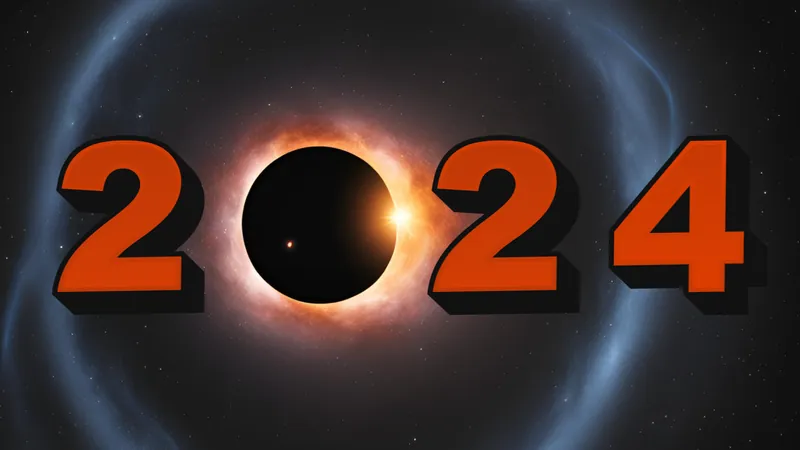
Mind-Blowing Black Hole Discoveries of 2024: What You Need to Know!
2024-12-30
Author: Michael
Our fascination with black holes is both profound and perplexing. These cosmic enigmas feature a one-way boundary known as the "event horizon," which captures light and prevents any signal from escaping. This creates an area in space that holds endless mysteries, captivating scientists and curious minds alike.
At the core of black holes lies a singularity where all known laws of physics cease to make sense. This makes them unique laboratories for examining the essence of our universe. In the last year alone, astronomers have unveiled astonishing findings about black holes that redefine our understanding of these celestial giants.
Here are the top seven black hole discoveries from 2024 that you can't afford to miss:
1) The Gluttonous Black Hole – A 'Sun a Day' Feeder!
In February, astronomers uncovered a supermassive black hole so distant that it took 12 billion years for its light to reach us. Dubbed J0529-4351, this black hole, weighing between 17 billion and 19 billion solar masses, is extravagant in its consumption, devouring the mass equivalent to one sun every day! “This makes it the brightest quasar ever observed,” remarked Christian Wolf from the Australian National University. Imagine a light source 500 trillion times brighter than our sun—talk about a cosmic party!
2) Surprising Binary Stars Found Dancing Near the Milky Way's Heart
In a revelation that challenged previous assumptions, a pair of binary stars named D9 were discovered orbiting close to Sagittarius A*, the Milky Way's supermassive black hole, in December. Given Sgr A*’s immense gravitational pull, scientists believed such stars couldn't survive nearby. This finding suggests that maybe planetary systems could also exist around these black holes, challenging the status quo of cosmic destruction theories.
3) Meet the First ‘Black Hole Triple’ – How Many Is Too Many?
In another startling discovery, astronomers identified a previously studied black hole system known as V404 Cygni as the first “black hole triple.” This includes a black hole consuming a companion star while being orbited by another star. Research implies that black holes can form in less violent ways than previously thought, raising questions about the formation of star systems in the cosmos.
4) Intermediate-Mass Black Holes Make an Appearance
After years of speculation, intermediate-mass black holes emerged from their hiding spots. In July, the Hubble Space Telescope captured one near Omega Centauri, a galaxy assimilated by our Milky Way. Following that, evidence of another was found near Sagittarius A*, suggesting these 'missing links' between stellar and supermassive black holes may be more common than scientists previously believed.
5) A 'Tantrum' from M87*: Explosions and Insights
The Event Horizon Telescope revealed a striking gamma-ray flare from M87*, a supermassive black hole, in late December. Analyzing this powerful outburst offers a unique opportunity to delve deeper into the makeup of accretion disks—the swirling masses of gas and dust that fuel these black holes—and could potentially help illuminate the origins of cosmic rays.
6) Gaia’s Groundbreaking Find: A Sleeping Giant Close to Home
In April, the Gaia space telescope discovered a black hole, dubbed BH3, located just 2,000 light-years from Earth. With a mass equivalent to about 33 suns, BH3 is the second closest black hole to our planet, shedding new light on the presence of dormant stellar-mass black holes in our vicinity. This discovery hints at a broader population of hidden black holes lurking within our galaxy.
7) Sgr A*: New Discoveries in Our Own Backyard
As 2024 progressed, renewed scrutiny of Sagittarius A* allowed astronomers to capture it in polarized light for the first time. This fascinating observation revealed that this supermassive black hole may have powerful magnetic fields organized around it, suggesting the possibility of a high-energy jet, similar to what is observed in M87*.
As 2025 looms just around the corner, we eagerly anticipate what new secrets black holes will reveal to us next. These breakthroughs serve as a testament to human curiosity and the indomitable spirit of exploration that continues to carry us through the cosmos. Join us in following these thrilling developments as we unravel the mysteries of black holes in the year ahead!



 Brasil (PT)
Brasil (PT)
 Canada (EN)
Canada (EN)
 Chile (ES)
Chile (ES)
 Česko (CS)
Česko (CS)
 대한민국 (KO)
대한민국 (KO)
 España (ES)
España (ES)
 France (FR)
France (FR)
 Hong Kong (EN)
Hong Kong (EN)
 Italia (IT)
Italia (IT)
 日本 (JA)
日本 (JA)
 Magyarország (HU)
Magyarország (HU)
 Norge (NO)
Norge (NO)
 Polska (PL)
Polska (PL)
 Schweiz (DE)
Schweiz (DE)
 Singapore (EN)
Singapore (EN)
 Sverige (SV)
Sverige (SV)
 Suomi (FI)
Suomi (FI)
 Türkiye (TR)
Türkiye (TR)
 الإمارات العربية المتحدة (AR)
الإمارات العربية المتحدة (AR)